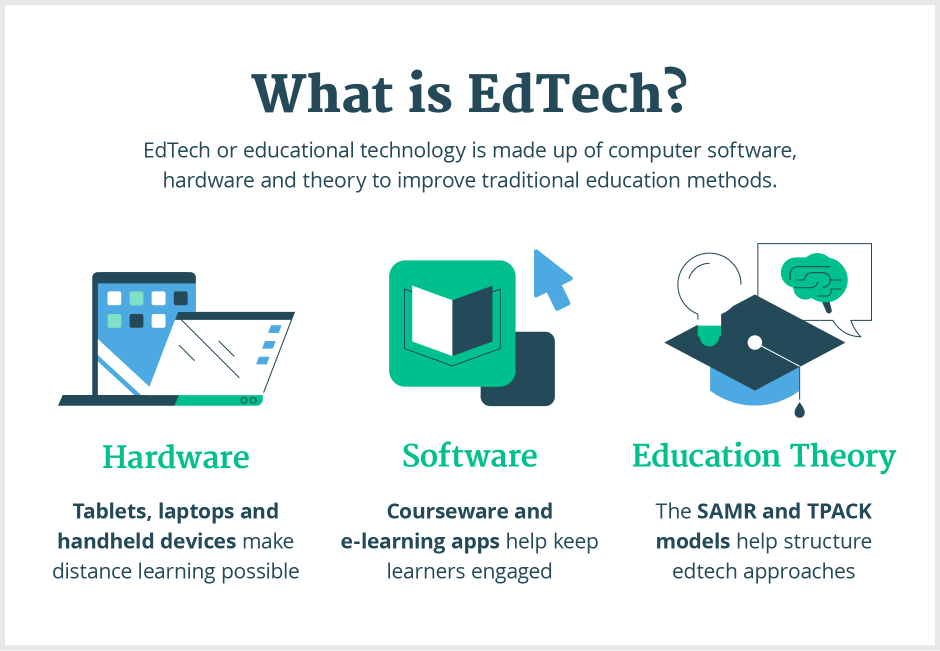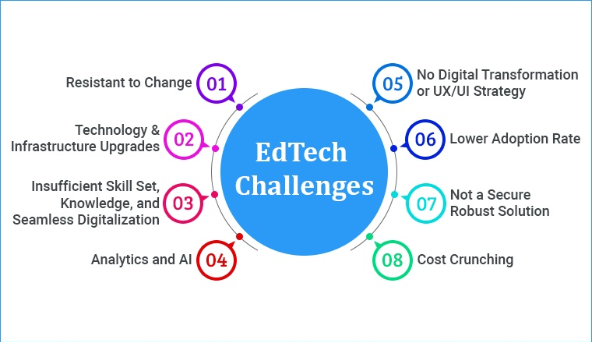ForumIAS announcing GS Foundation Program for UPSC CSE 2025-26 from 19 April. Click Here for more information.
Contents
| For 7PM Editorial Archives click HERE → |
Introduction
Since a decade, Education Technology or EdTech, as it is popularly known, and its potential to provide affordable learning at scale have been a matter of discussion in academic and policy circles. In recent years, news about India’s EdTech sector startups raising billions has hit the headlines. Hence, it is important to understand its nuances, potential, challenges, and impact in nurturing the largest student base.
What is EdTech?

EdTech, or Education Technology, refers to the use of the Information and Communications Technology (ICT) ecosystem to enhance teaching and learning. It includes the use of smartphones, apps, and online platforms to make education more accessible, affordable, and engaging. EdTech allows students to learn at their own pace and provides access to quality teachers and resources, regardless of location or learning abilities. It has the potential to transform education by offering personalized learning experiences and improving educational outcomes for students.
What are the key growth drivers of India’s EdTech sector?
Demographic dividend: Large student population and increasing enrollment rates create a significant market for EdTech. For instance, with over 300 million students in K-12 and around 40 million students in higher education, there is immense potential for EdTech to reach and impact a large number of learners.
Expansion of digital infrastructure: Initiatives like the National Broadband Mission, Digital India, and BharatNet have significantly expanded digital infrastructure in the country. This has improved internet connectivity, making it easier for EdTech platforms to reach remote areas and provide online education to students across the country.
Increased Internet and Smartphone users: The rise in the number of Internet users and smartphone users in India has created a large user base for EdTech platforms. With over 932 million internet users and 931 million smartphone users, EdTech has the potential to reach a vast number of students and provide them with quality education through digital platforms.
Affordable mobile data rates: India has one of the cheapest mobile data rates globally, with 1 GB costing only Rs 14. This affordability has made internet access more accessible to a wider population, enabling students from diverse backgrounds to access online educational resources and benefit from EdTech platforms.
Decreasing smartphone prices: Over the last decade, there has been a significant drop in smartphone prices in India. The average selling price has decreased by around 12%. This affordability has made smartphones more accessible to students, allowing them to access EdTech apps and platforms for learning purposes.
Government initiatives: Programs like SWAYAM, DIKSHA, and the introduction of the National Digital University (NDU) support the growth of digital education. Such as, SWAYAM provides free online courses from the best universities, allowing students to access quality education at no cost.
Pandemic-led behavioural Changes: The COVID-19 pandemic has accelerated the adoption of online education and increased the demand for EdTech solutions.
Increased funding: EdTech has attracted significant investments from venture capitalists and private equity firms, enabling companies to expand their offerings and reach a larger user base.
| Read more: India’s edtech ecosystem: Let our learning curve be hybrid, holistic and hyper-personalized |
What are the potential benefits of India’s EdTech sector?

Learning while playing: Gamified techniques in EdTech make learning fun and interactive. For example, educational games that teach math concepts through puzzles and challenges.
Classes anywhere and anytime: EdTech allows students to access classes and educational resources remotely. Like, online learning platforms that offer recorded lectures and interactive lessons accessible 24/7.
Access to quality teachers: EdTech enables students to learn from experienced and qualified teachers, regardless of their location.
Engaging learning experience: EdTech incorporates interactive elements into the curriculum, enhancing student engagement. Such as interactive simulations and virtual labs that allow students to explore and experiment in a virtual environment.
Personalized learning: EdTech platforms can adapt to individual student needs and provide personalized learning experiences. Like, adaptive learning software that adjusts the difficulty level of questions based on a student’s performance.
Improved administrative tasks: EdTech tools automate administrative tasks, saving time and effort for teachers. For example, classroom management software assists in grading assignments and organizing student records.
Enhanced collaboration and communication: For instance, online discussion boards and video conferencing tools for group projects and virtual classrooms. Access to diverse educational resources: EdTech platforms offer a wide range of educational materials, including e-books, videos, and interactive tutorials.
What are the challenges faced by India’s EdTech sector?

Access and infrastructure disparities: Unequal access to technology and internet connectivity among students, particularly in rural or underserved areas, can hinder the widespread adoption of EdTech.
Digital literacy and skills gap: Students, teachers, and parents may face challenges in adapting to and effectively utilizing EdTech tools and platforms due to a lack of digital literacy and skills.
Equity and inclusion: Ensuring equitable access to EdTech resources and opportunities for all students, including those from marginalized communities, is a challenge.
Data privacy and security: Protecting sensitive student data and ensuring the security of online platforms and systems is a critical concern in EdTech implementation.
Teacher training and professional development: Providing adequate training and professional development opportunities for teachers to effectively integrate EdTech into their teaching practices can be challenging.
Psychological and social effects of online education: Lack of face-to-face interaction and socialization opportunities in online education can impact students’ mental health and social skills. For instance, students may experience feelings of isolation or struggle to develop interpersonal skills without in-person interactions.
Perception of parents: Some parents may have reservations about the effectiveness and reliability of EdTech compared to traditional classroom-based education. Such as concerns about the quality of instruction or the ability to provide holistic learning experiences may lead parents to prefer traditional education methods.
Pupil-teacher ratio: Maintaining a low pupil-teacher ratio in online education programs is essential to ensure personalized attention and support for students. For example, limited teacher availability and the challenge of providing individualized guidance to a large number of students in virtual classrooms.
| Read more: Edtech’s teachable moment |
How India’s EdTech sector will evolve in future?
Personalized learning experiences: Advancements in Artificial Intelligence (AI) can enable EdTech platforms to provide individualized learning experiences for students. AI algorithms can adapt to student’s learning styles, pace, and preferences, delivering customized content and recommendations. This can lead to more efficient and effective learning, catering to the unique needs of each student.
Integration of emerging technologies: EdTech is likely to incorporate emerging technologies such as Virtual Reality (VR), Augmented Reality (AR), and Mixed Reality (MR) to create immersive and engaging learning environments.
Blended learning approaches: This approach combines traditional classroom instruction with digital resources and platforms, offering a hybrid learning experience.
Lifelong learning and skill development: Online platforms and courses will cater to professionals seeking continuing education and individuals acquiring new skills to adapt to changing job market requirements.
Data-driven insights and analytics: EdTech’s future will likely involve leveraging data analytics to gain insights into student performance, learning patterns, and areas of improvement.
Collaboration and global connections: EdTech will continue to facilitate collaboration and global connections among students, educators, and experts. Virtual classrooms, online discussion forums, and collaborative projects will promote cross-cultural exchanges and knowledge sharing.
Focus on future Skills: EdTech will increasingly emphasize the development of future skills, such as critical thinking, problem-solving, creativity, and digital literacy. Adaptive learning platforms can incorporate these skills into their curriculum and assessments, preparing students for the demands of the 21st-century workforce.
| Read more: Technology can democratise education |
What should be done?
Continue investing in improving digital infrastructure: Such as internet connectivity and network coverage, particularly in remote and underserved areas. Government initiatives should focus on bridging the digital divide to ensure equitable access to EdTech resources for all students.
Promote digital literacy and skills: Incorporate digital literacy programs into school curricula and provide training for students, teachers, and parents on effectively using EdTech tools and platforms.
Collaborate with stakeholders: Foster collaboration between educational institutions, EdTech providers, policymakers, and parents to create a shared vision and effective implementation strategies.
Continuous teacher training and support: Provide comprehensive training and professional development programs for teachers to effectively integrate EdTech into their teaching practices. Support teachers in adapting to new technologies, designing engaging online learning experiences, and utilizing data analytics to personalize instruction.
Ensure data privacy and security: Establish robust data privacy policies and guidelines to protect sensitive student information and ensure secure online platforms. Regularly assess and update security measures to maintain the integrity and confidentiality of student data.
Promote research on the impact and effectiveness of EdTech: Conduct evaluations to measure the outcomes and benefits of EdTech implementations, identifying areas of improvement and best practices.
Source: Yojana
Syllabus: GS 2: Social Justice: Issues relating to development and management of Social Sector/Services relating to Education




